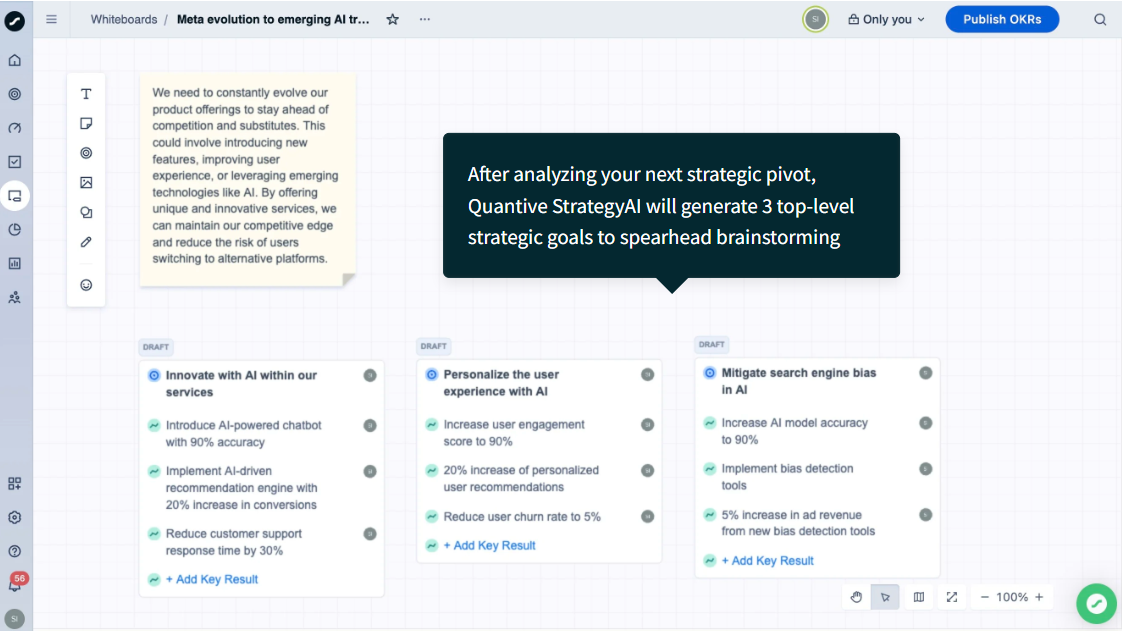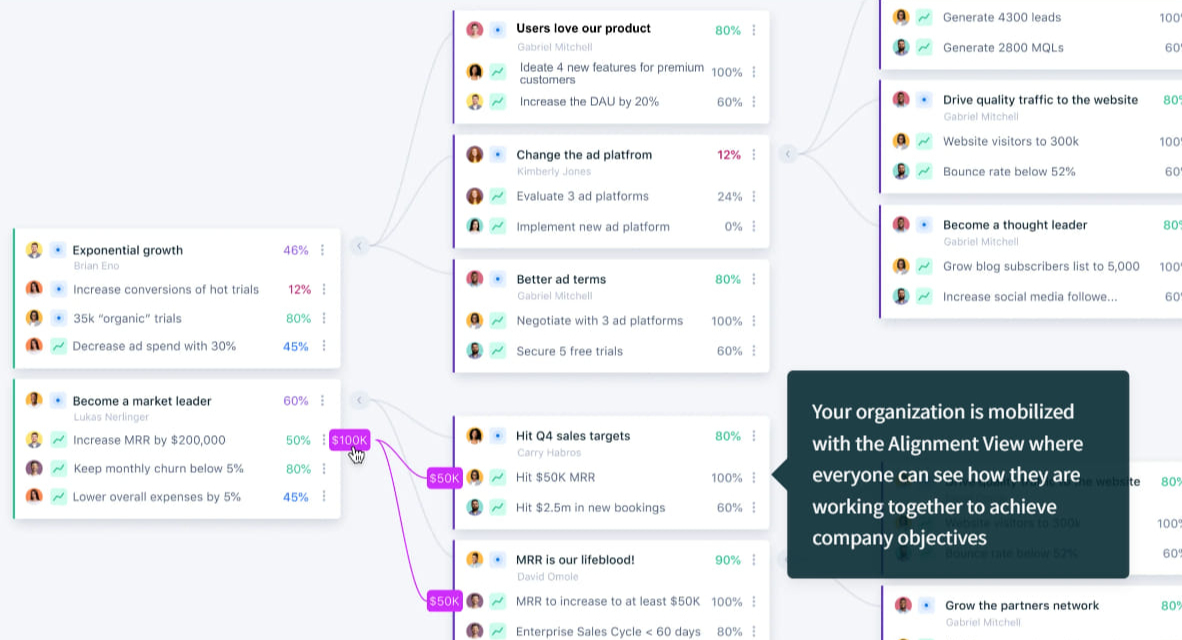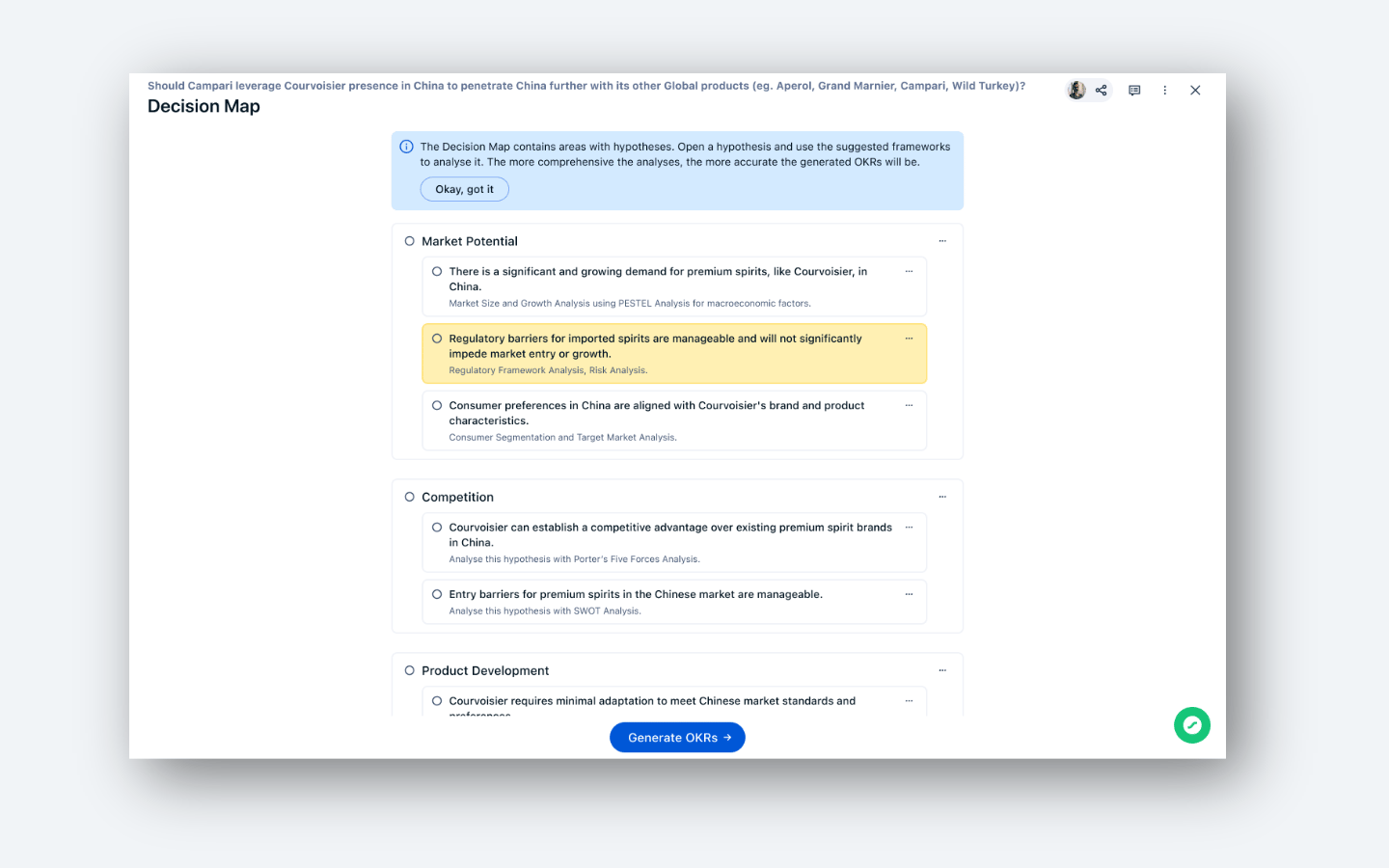Quantive is now part of WorkBoard. Get to know WorkBoard:
If a company's strategy fails to gain traction, does that mean it was simply bad? Perhaps, but it's more likely that the company had a good strategy — and something broke during execution.
A business strategy is just words on paper until you put it into action. Crossing that gap between idea and action is called strategy implementation.
Mastering strategic implementation — thinking it through step by step and getting your whole team involved — helps you pursue and achieve your high-level business objectives. With the right approach and technology, your organization can get implementation down to a science.
What is strategy implementation?
Strategy implementation is the fourth stage of the strategic management process, where a strategic plan is put into action. Good strategy implementation ensures that the right processes, people, resources, and communication are in place for your organization to achieve its strategic objectives.
Numerous smaller processes go into strategy implementation. For example, your company should create a plan, outline goals, and map our tactics to guide you from an initial idea to successful execution. You'll also need to get all team members on board with the strategy implementation process.
As with all components and phases of strategy management, the strategy implementation phase is best handled using a strategic management platform. It provides a shared space for teams and departments to collaborate.
To assess your current level of success with your strategy implementation plan, ask yourself how well your plans translate to the real world. Does your company have ongoing successful strategy execution? Are your teams carrying out the business's overall vision and strategic plan for the year or the quarter and achieving measurable results? Becoming more adept at and deliberate about strategy implementation closes gaps between the strategy formulation and the strategic results.
Why is successful strategy implementation important for organizations?
A structured and well-defined approach to strategy implementation will strengthen your company's ability to execute strategy effectively, minimize wasted effort, and maximize ROI.
The most direct reasons to focus on your strategy implementation plan are:
- Aligning everyday work with strategic goals: Strategy implementation is the process that ensures employees' efforts are aligned with the goals laid out in the strategy. This minimizes duplicate work and conflicting priorities.
- Enhancing resource efficiency: When teams are aligned on strategy, resources directly support business goals, showing a clear link between spending and results.
- Improving adaptability and responsiveness: Well-implemented strategies allow teams to respond quickly to dynamic environments and challenges.
Setting and tracking measurable goals provides a solid baseline as your organization implements its new strategy. Pick frameworks that will help you keep your people on the same page as you allocate resources to teams and projects that add strategic value.
What are the 5 key stages of strategic implementation?
Making strategy implementation work for your business means following a disciplined path and turning your ideas into results. Every company is different, and your objectives and internal dependencies will shape your strategic implementation process, but this five-stage process can keep you organized.
At each step, you'll also see how the right technology — the Quantive StrategyAI strategy management platform — makes these actions run smoothly.
Stage 1: Setting clear objectives
Your strategy's objectives should be clear and realistic regarding long-term business objectives and the incremental, measurable goals that will lead to these endpoints. There needs to be a balance between aspiration and your potential ability to reach your targets, so you need accurate information about your current position to use as a starting point.
Pro Tip: Use Quantive StrategyAI’s AI-assisted goal setting to avoid vague, misaligned goals. The platform recommends clear, high-impact objectives based on your business context to ensure every team works toward measurable business outcomes.

Stage 2: Resource allocation
To set your strategy up for success, ensure teams have what they need to execute successfully at every stage, whether budget, technology, talent, or time.
Pro tip: Optimize resources before bottlenecks appear. Use Quantive StrategyAI’s interactive whiteboards to map out dependencies, anticipate constraints, adjust allocations in real-time, and utilize weekly team check-ins to determine whether teams have the right tools, budget, and capacity to execute without delays.

Stage 3: Assigning roles and responsibilities
People need to know what they're responsible for at every step of the plan. Clear and visible goals, tasks, project assignments, and tracking progress toward strategic initiatives can keep your workforce aligned and productive.
Pro tip: Eliminate misalignment and execution gaps by directly assigning goals, tasks, and KPIs in Quantive StrategyAI. This will give every team member clear visibility into their responsibilities and contributions, reducing redundant work and ensuring full accountability across strategic initiatives.

Stage 4: Execution and monitoring
When carrying out your business strategy's activities, monitoring progress at a short, regular cadence is important. This approach allows you to adjust quickly and prevents work from being wasted on non-strategic activities.
Pro tip: Stay ahead of execution roadblocks with Quantive StrategyAI’s real-time dashboards and AI-powered alerts. Monitor key metrics, detect risks early, and make course corrections instantly. You will no longer wait for quarterly reviews to fix execution roadblocks.

Stage 5: Strategic evaluation and adaptation
Larger-scale strategic evaluation of business performance is the key to updating strategic assumptions. This continual assessment is part of an Always-On Strategy, an approach designed to reduce wasted efforts by supporting more frequent pivots and adjustments based on feedback.
Pro tip: Adapt your strategy before it’s too late. Quantive StrategyAI provides continuous performance insights and built-in strategic frameworks to support comprehensive decision maps, allowing you to validate assumptions, adjust objectives, and align your organization with shifting market conditions.

Iterating upon your strategy helps you stay in line with your overall objectives, ensuring you never lose sight of the big ideas that inspired you in the first place. Your company has a mission, and effective strategy implementation keeps you from straying from it.
What is an example of strategy implementation?
Implement a strategy correctly, and the results will speak for themselves. Organizations leading their industries with bold new approaches reach that pinnacle through smooth implementation. Without such focus on the mechanics of realizing their ideas, those concepts would never have made it into production.
Here’s an example that will help you understand what a successful strategy implementation looks like:
IBM's pivot to on-demand business
The transformation of computing giant IBM throughout the 1990s is one of the most cited cases of strategic implementation because of the sheer magnitude of the turnaround. The company, suffering from increasing costs and complexity, undertook a focused modernization.
Stage 1: Setting clear objectives
IBM set clear objectives for its strategic transformation:
- Reposition the company as a leader in the emerging Internet revolution
- Streamline operations and reduce costs
- Revitalize innovation and technical achievement
- Transform company culture to be more responsive and adaptable
Stage 2: Resource allocation
IBM allocated resources strategically to support its transformation:
- Reinvested in research and development to drive innovation
- Implemented cost-cutting measures to free up resources for strategic initiatives
- Divested non-core businesses to focus on key areas of growth
Stage 3: Assigning roles and responsibilities
IBM restructured its organization to clarify roles and responsibilities:
- Installed new leadership with Lou Gerstner as CEO to drive change
- Moved from a loose confederation of business units to a more integrated model
- Formed an executive advisory group representing every business unit to ensure alignment
Stage 4: Execution and monitoring
IBM closely monitored the execution of its strategy:
- Implemented rigorous cost-cutting measures, achieving $5 billion in cost avoidance and savings
- Tracked progress on organizational restructuring and cultural transformation
- Monitored the success of its "e-business" strategic vision in positioning the company
Stage 5: Strategic evaluation and adaptation
IBM continuously evaluated and adapted its strategy:
- Shifted from a self-confident, insular culture to one that was leaner and more responsive
- Adjusted its approach based on market feedback and internal performance metrics
- Maintained financial discipline while adapting to changing market conditions
All these steps came true thanks to careful planning, exceptional communication, and operational excellence.
Common challenges (and fixes) in strategy implementation
Even with a solid strategy, things can fall apart when it’s time to execute. Let’s break down the most common blockers and how to overcome them.
Resistance to change and poor communication
Less than 5% of employees have a basic understanding of their company's strategy. (HBR)
People resist change. It’s natural — new strategies can trigger fear, confusion, or a longing for the old way of doing things. But even the best plan will stall if you don’t get buy-in early.
Here’s what helps:
- Make the process transparent and inclusive.
- Involve teams in shaping the strategy, not just delivering it.
- Repeat the “why” behind the shift often, especially during challenging transitions.
Communication is a close cousin to resistance. If people don’t understand the strategy or their role in it, execution suffers. Run regular strategy check-ins, share progress broadly, and keep everyone looped in on what’s changing and why.
Solutions with Quantive StrategyAI
Quantive StrategyAI helps build early buy-in by making strategy visible, interactive, and inclusive. It brings teams into the process with real-time updates, collaborative planning tools, and check-ins that connect everyone to the “why” behind the work. Less confusion. More momentum.
Learn how to prepare your teams for strategic shifts

Misalignment and resource constraints
When teams don’t pull in the same direction, execution feels like a tug-of-war. Misalignment leads to duplicate efforts, competing priorities, and wasted time.
The fix:
- Visualize alignment across teams using frameworks like Hoshin Kanri.
- Map goals clearly to teams, owners, and metrics.
- Use strategy platforms that show alignment in real time.
On the resource side, many plans fail simply because there aren’t enough people, budget, or tools to make them happen. If your strategy isn’t baked into budgeting or operational planning, it becomes wishful thinking. Prioritize, plan, and ensure resources follow strategy, not vice versa.
Solutions with Quantive StrategyAI
Quantive gives you the visibility you need for your strategic actions. Teams see where they fit, leaders spot misalignment instantly, and resources follow priorities, not internal politics. With shared visibility and clear ownership, everyone pulls in the same direction — even when plans shift.
Weak leadership and unclear accountability
Leadership is the engine behind execution. But many leaders lack the right skills, and even fewer create systems for real accountability.
What helps:
- Build a leadership culture focused on strategic follow-through.
- Assign clear ownership for every objective, task, and KPI.
- Block time for strategy review sessions (and show up to them).
- Tie strategy execution to team structures and reward systems.
Accountability is more than tracking tasks — it’s about making strategy part of the day-to-day, not an afterthought.
Solutions with Quantive StrategyAI
Quantive StrategyAI builds accountability into the system. Everyone knows what they own and how it’s progressing, from goal owners to KPI leads. And with executive-ready views and structured review cadences, leaders drive follow-through instead of chasing it.
Culture mismatch and unexpected external factors
Your strategy won't succeed if the culture doesn’t support it. Strategy will also stall if teams aren’t trained, trusted, or encouraged to take risks.
Create a culture that:
- Embraces performance and accountability
- Encourages innovation and learning
- Links day-to-day behavior with long-term vision
Then there’s the external world: market shifts, new competitors, changing regulations. These can throw even the best strategy off track.
Be ready to pivot:
- Build flexibility into your execution plan
- Monitor the market continuously
- Adjust your approach without losing sight of the bigger goal
Solutions with Quantive StrategyAI
Strategy becomes a living system that’s responsive, measurable, and adaptable. You get automated signals and alerts to spot changes early, adjust goals in real time, and shift direction without derailing execution.
Make strategy implementation work for your organization
A focused approach to strategy implementation, paired with effective purpose-built technology, helps ensure your most ambitious concepts make it past brainstorming and into the world. Strategic planning is only a powerful, impactful effort if you put it to practical use.
When you see companies refitting their operations or changing their industries with bold strategies, you're not just witnessing businesses with big ideas. You're seeing the strategy implementation process in action. Achieving those results for your own business requires contributions from all levels, effective resource allocation, and a way to measure progress and make key adjustments.
Quantive StrategyAI is the right solution to support you in these efforts. It acts as a centralized point to manage your entire strategy. Try it for free to see how it can help you.





